In Lexus parlance, F stands for finesse, fun and Fuji
What is it?
It’s the ultimate factory build for the midsize Lexus GS sedan, and the next addition to the ultra-performance F brand from Lexus. The GS F’s job, besides making its owners happy: Build enthusiast cred, put Lexus on equal footing with European competitors like BMW M and Mercedes AMG and drive sales of the lucrative F-Sport option on other Lexi, including the standard GS 350. The GS F’s competitive set spans the Audi S6/RS7, BMW M5, Cadillac CTS-V and Mercedes-Benz E63 AMG.
Interior volume and exterior dimensions line up closely with those competitive sedans. The GS F starts with what is already Lexus’s stiffest unibody, according to F development engineers, and adds significant structural reinforcement for track duty, including three rectangular underbody braces and new rear suspension mounts.
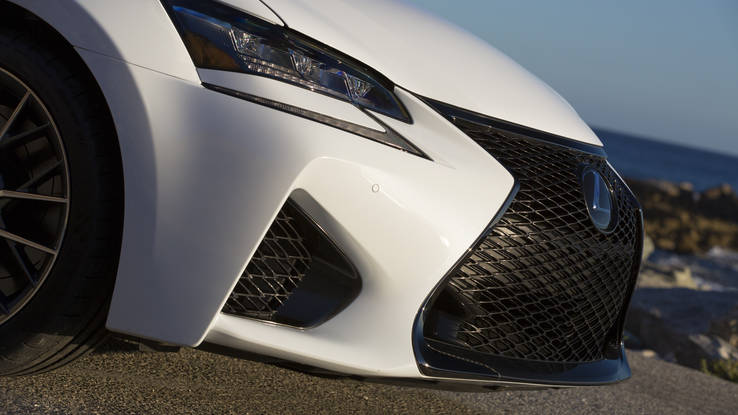
The 2016 Lexus GS F gets the brand’s spindle grille and oil/transmission fluid coolers behind the secondary grilles.
Naturally, the F is meant to look more purposeful than the standard GS. Its sheetmetal and moldings are entirely different from the front roof pillars forward. The most obvious distinction is larger grilles at the corners off the front end — one each for an oil and transmission-fluid cooler. Air flows through the coolers, over the front brake rotors and out gills near the trailing edge of the front fenders. There’s a more pronounced, carbon-reinforced lip at the bottom of the hourglass center grille and a carbon fiber spoiler on the trunk lid. Exhaust tips are stacked diagonally in the corners of the rear diffuser. The effect is unique and something like manga comics, without going overboard to Transformers-grade.
The most significant upgrade sits under the GS F’s hood, of course. Its engine is an evolution of Lexus’s original 5.0-liter F V8 and identical to that in the RC F, with the same 12.3:1 compression ratio and the same dual-injection system. Lexus says it uses both direct and conventional port fuel injection, with an extra set of injectors, feed lines and some really complicated software, to add another control lever. We’d guess that the ultimate reason is inhibiting carbon build-up other manufacturers are finding in their high-tech DI engines. With its introduction in the GS F, Lexus has added another step to the 5.0’s production. After the engine is assembled and before it goes in the car, Lexus rebalances the crank with external weights on the damper, more or less like balancing a wheel.
At 467 peak hp and 389 lb-ft of torque, the F V8 is underpowered compared to its blown competitors. While the GS F is at least a hundred pounds lighter than any of them, that isn’t enough to level its power-to-weight ratio. Each horse pulls 8.6 pounds, and the GS F beats only the Audi S6. The class-leading CTS V — 1 hp for each 6.5 pounds — is 32 percent better.
On the positive side, the F V8 remains the only naturally aspirated engine in its group. That pays handsomely in rev rate and sweet sounds, and the Lexus engine seamlessly switches between conventional Otto cycle and more fuel-efficient Atkinson cycle operation. Its motor-driven cam phasers can keep the intake valves open longer at light loads, effectively creating an Atkinson cycle and reducing effective displacement to 4.2 liters, according to F engineers.
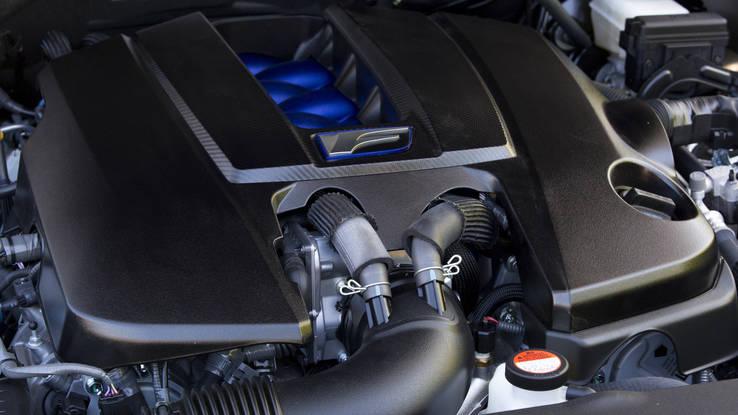
Five liters of naturally-aspirated power sits under the Lexus GS F hood.
The transmission, too, is identical to the RC F’s: an eight-speed automatic with a die-cast aluminum case and internals, a G sensor to optimize shift control during track use and a clutch that locks the torque converter during manual operation.
Lexus’s torque-vectoring differential—optional on the RC F—is standard on the GS F. There’s a planetary gear set, clutch pack and electric motor on each side of the rear end. These distribute torque as needed to create a yaw moment and help vector the GS F though corners. Torque distribution is managed in .001 second increments, according to Lexus, but the neatest trick is that the diff can vector even during deceleration, adjusting coast torque to either side during turn-in.
Everything in the suspension is changed from the standard GS, including geometry, to accommodate the F’s track and fatter tires. The GS F gets unique forged aluminum control arms, firmer springs and stiffer bushings, but the most notable difference is philosophical. Where the standard GS and the high-performance competition have switched to electronic variable damping, the GS F goes with old-fashioned Sachs mono-tube shocks. That narrows the range of damping rates, but it also trims weight, complexity and cost. F engineers say the conventional suspension works better in the band they seek, and they think F buyers will happily tolerate a firmer road ride.
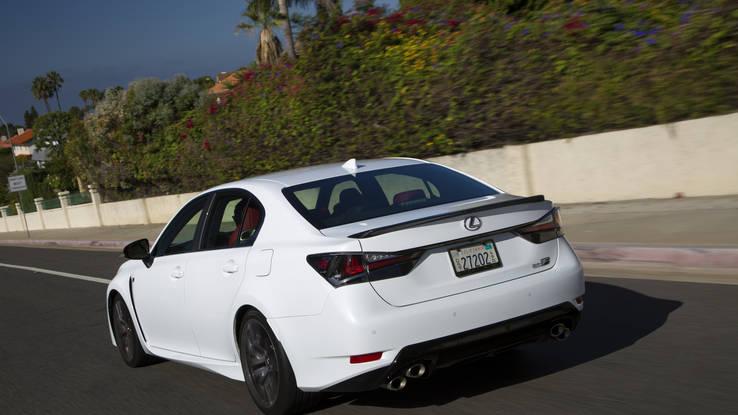
The 2016 Lexus GS F sports the brand’s trademark canted rear exhausts.
How’s it drive?
It’s on a different plane compared to the GS 350, when speed is what one seeks. True to the F brand promise, the GS F allows almost anyone who can afford it to discover the joys of nitrite-popper acceleration out of a corner or dizzying lateral g loads — in a progressive, relatively safe fashion. It doesn’t hide its charms behind a veil of intimidation.
The GS F feels lighter than some of its competitors on track, and really no heavier than the compact RC F coupe. It’s hard to find significant dynamic differences between the F models. Fully credentialed pros might find some — subtle differences in balance, for example — but the rest of us probably won’t. The GS F could use more horsepower, if that doesn’t sound ridiculous for a car with 467. It has the finesse, stability and solidity for at least 100 more.
Not that 467 is anything to sneeze at. This Lexus delivers acceleration times that were the stuff of adolescent wet dreams 10 years ago, and you don’t need a racetrack to know. Boot it on any empty stretch and it will downshift a couple of gears, press you into the seat and blast. The back wheels will skip laterally in the upshift from second to third, even as the traction electronics do their work. Yet beyond that brief interruption in traction, it’s silk. When competitors are gasping for more forced air and stuttering under the weight of their own internal inertia, the normally aspirated GS F has another thousand rpm of free breathing.
It sounds better, too. Lexus felt compelled to fit the GS F with digitalized engine sound, only here we actually like it. Active Sound Control uses two speakers in the cabin, feeding synthesized mechanical noise through one or both, depending on drive mode and throttle application. You’ll drive yourself nuts trying to distinguish real from virtual, and if you can’t abide, you can switch ASC off and lower the windows.
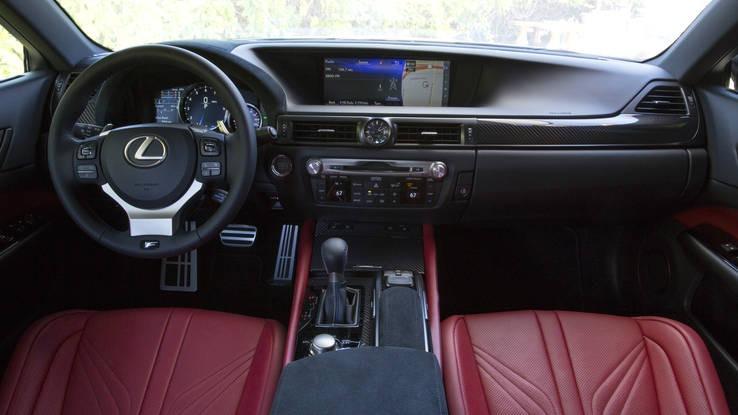
The GS F interior will be familiar to any Lexus owner.
The eight-speed might be the best of all worlds — at least in the fashion of current performance sedans. It seems as good as a dual-clutch in manual mode, and it’s more civilized through transit stages. Operated like a stick, the GS F trans protects against over-revving on downshifts, but from second gear north it will let you bounce off the 7,300-rpm limiter all afternoon without shifting itself up. As a full automatic on track — well, the GS F will shift better and faster than you can learning the way around a new circuit — guaranteed. Yet there’s no payback in jerk and lurch when you’re coasting toward a stop sign or puttering through town on the way home.
The GS F presents world-class, flex-free body structure and good suspension tuning, no fancy adaptive shocks required — kind of what we used to love about BMWs. It requires a bit more steering effort than most cars in the class, and we like that. On track, the skid-control electronics are protective, but not stifling. Head into a corner slow and get on the gas hard, and the GS F will slide in back no problem, or throttle back if the traction control is on. Brake too late and turn in too quickly, and it will push. You’ll just stay off the gas and slow down. In sport-plus, you’ll feel the car move around a bit more under hard braking, as the electronics aren’t correcting as quickly or constantly. Even then, the worst trouble you’re likely to encounter is going in way too hot and pushing toward the opposite edge.
Even with the narrower bandwidth in the conventional shocks, the GS F doesn’t feel overtly stiff on the road — at least on smooth roads in rural Spain. We may think differently back home in the Motor City. The ride is firm, and there’s some slap and chatter as the energy from loaded sport tires finds its way up the steering shaft. That’s a good thing on a track, and on the road it doesn’t seem too steep a price for a solid track car.
The sport seats are grippy, but not hard to settle into. The hard plastics inside don’t impress much, but they’re the biggest complaint, and most are covered with Alcantara in the GS F. There’s a flat, forward-canted center stack with a giant VGA screen above. Direct-access switches are concentrated in the stack, and there’s one for most adjustments you really care about. The drive mode selector and a point-and-click knob are located on the console. It’s not the typical Euro-knockoff switch collection, and it’s better than many.
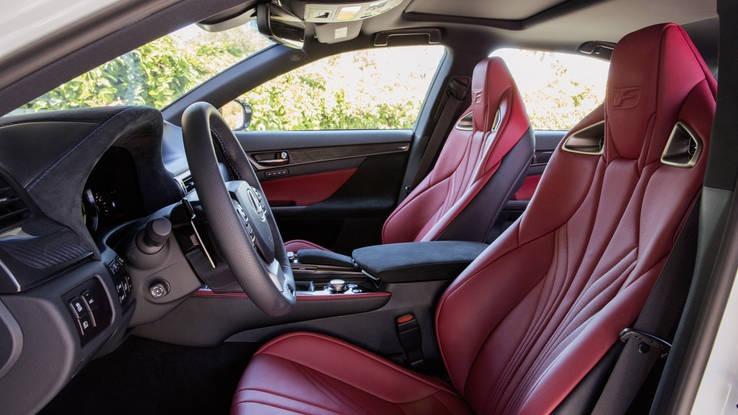
Sport seats help the Lexus GS F driver stay in position during aggressive handling.
Do I want it?
Let’s say you want the hottest post-LFA Lexus there is. Do you want the GS F sedan or the RC F coupe?
The GS F has a real back seat and more trunk space, so it probably makes the more practical car. It might be better looking (at least more graceful) and the weight difference isn’t as significant as you’d guess — just over 100 pounds when the RC F has the torque-vectoring diff, if published curb weights can be trusted.
The problem? The compact RC F brings the same power as the GS F, and a much more competitive power-to-weight ratio compared to its competition, which includes the Audi RS5, BMW M4 and Cadillac ATS V. The GS-F looks like an X-rated sedan, but it’s R-rated compared to a comparably priced, 640-hp CTS V.
The GS F is still well sorted, and it sounds better than its competition. It does exactly what Lexus says it should. While the Europeans are starting to feel a bit generic, the GS F has a style all its own.




























